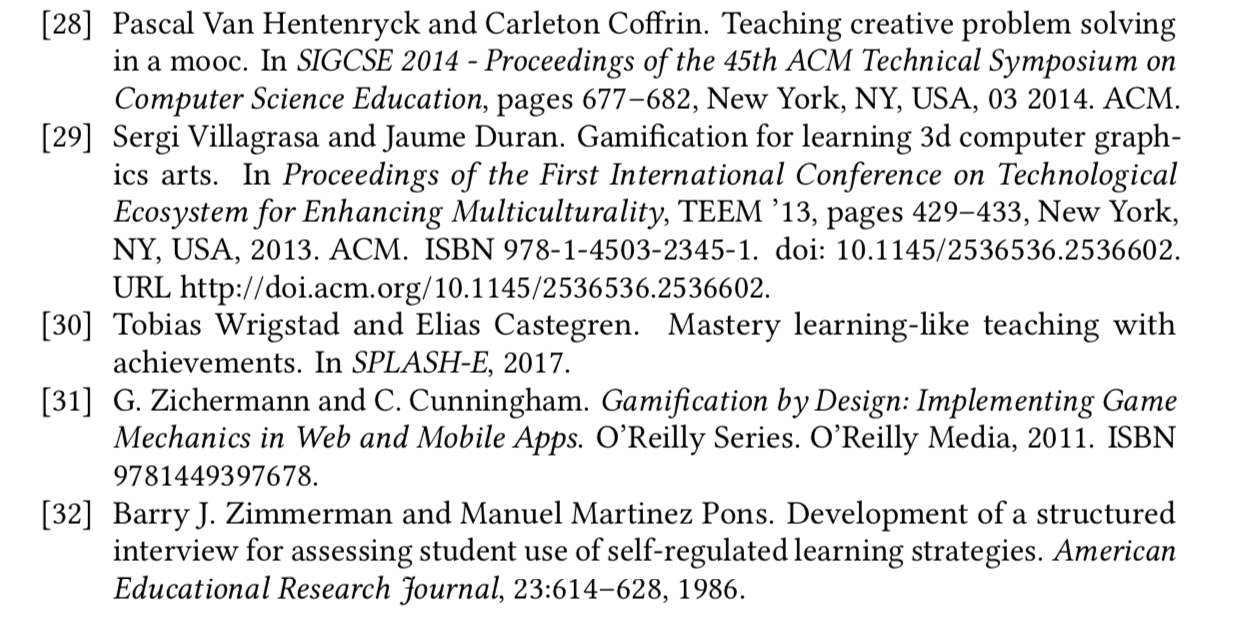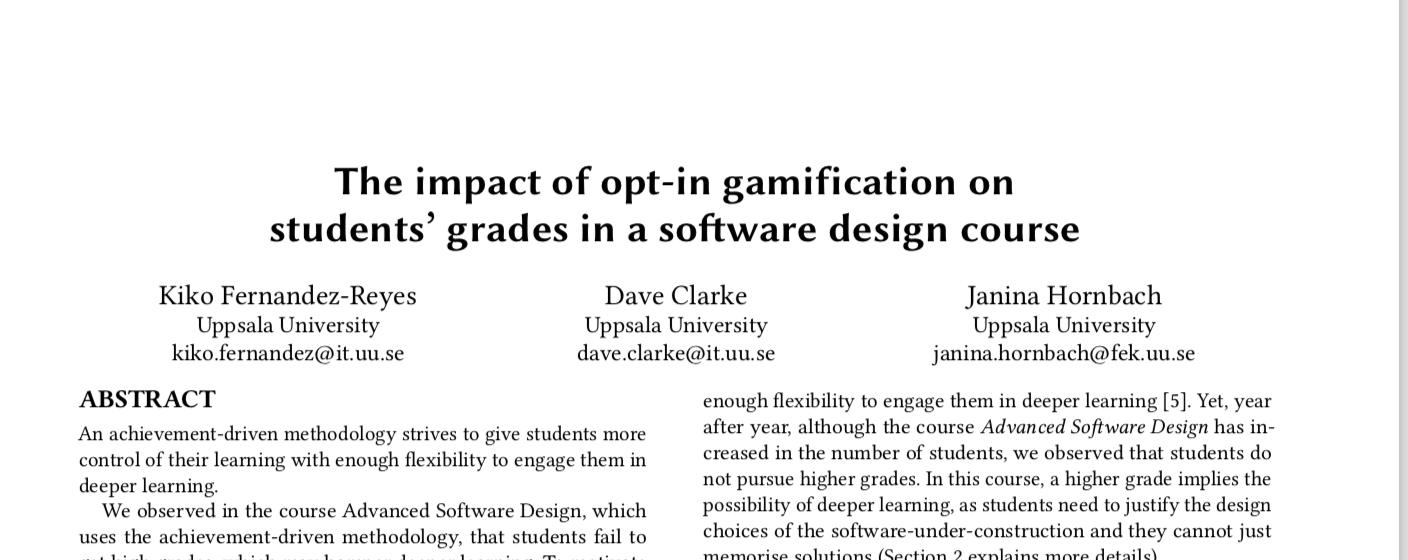mirror of
https://github.com/LCTT/TranslateProject.git
synced 2025-01-13 22:30:37 +08:00
336 lines
15 KiB
Markdown
336 lines
15 KiB
Markdown
用 Pandoc 生成一篇调研论文
|
||
======
|
||
|
||
> 学习如何用 Markdown 管理章节引用、图像、表格以及更多。
|
||
|
||

|
||
|
||
这篇文章对于使用 [Markdown][1] 语法做一篇调研论文进行了一个深度体验。覆盖了如何创建和引用章节、图像(用 Markdown 和 [LaTeX][2])和参考书目。我们也讨论了一些棘手的案例和为什么使用 LaTex 是一个正确的做法。
|
||
|
||
### 调研
|
||
|
||
调研论文一般包括对章节、图像、表格和参考书目的引用。[Pandoc][3] 本身并不能交叉引用这些,但是它能够利用 [pandoc-crossref][4] 过滤器来完成自动编号和章节、图像、表格的交叉引用。
|
||
|
||
让我们从重写原本以 LaTax 撰写的 [一个教育调研报告的例子][5] 开始,然后用 Markdown(和一些 LaTax)、Pandoc 和 Pandoc-crossref 重写。
|
||
|
||
#### 添加并引用章节
|
||
|
||
要想章节被自动编号,必须使用 Markdown H1 标题编写。子章节使用 H2-H4 子标题编写(通常不需要更多级别了)。例如一个章节的标题是 “Implementation”,写作 `# Implementation {#sec: implementation}`,然后 Pandoc 会把它转化为 `3. Implementation `(或者转换为相应的章节编号)。`Implementation` 这个标题使用了 H1 并且声明了一个 `{#sec: implementation}` 的标签,这是作者用于引用该章节的标签。要想引用一个章节,输入 `@` 符号并跟上对应章节标签,使用方括号括起来即可: `[@ sec:implementation]`
|
||
|
||
[在这篇论文中][5], 我们发现了下面这个例子:
|
||
|
||
```
|
||
we lack experience (consistency between TAs, [@sec:implementation]).
|
||
```
|
||
|
||
Pandoc 转换:
|
||
|
||
```
|
||
we lack experience (consistency between TAs, Section 4).
|
||
```
|
||
|
||
章节被自动编号(这在本文最后的 `Makefile` 当中说明)。要创建无编号的章节,输入章节的标题并在最后添加 `{-}`。例如:`### Designing a game for maintainability {-}` 就以标题 “Designing a game for maintainability”,创建了一个无标号的章节。
|
||
|
||
#### 添加并引用图像
|
||
|
||
添加并引用一个图像,跟添加并引用一个章节和添加一个 Markdown 图片很相似:
|
||
|
||
```
|
||
{#fig:scatter-matrix}
|
||
```
|
||
|
||
上面这一行是告诉 Pandoc,有一个标有 Scatterplot matrix 的图像以及这张图片路径是 `data/scatterplots/RScatterplotMatrix2.png`。`{#fig:scatter-matrix}` 表明了用于引用该图像的名字。
|
||
|
||
这里是从一篇论文中进行图像引用的例子:
|
||
|
||
```
|
||
The boxes "Enjoy", "Grade" and "Motivation" ([@fig:scatter-matrix]) ...
|
||
```
|
||
|
||
Pandoc 产生如下输出:
|
||
|
||
```
|
||
The boxes "Enjoy", "Grade" and "Motivation" (Fig. 1) ...
|
||
```
|
||
|
||
#### 添加及引用参考书目
|
||
|
||
大多数调研报告都把引用放在一个 BibTeX 的数据库文件中。在这个例子中,该文件被命名为 [biblio.bib][6],它包含了论文中所有的引用。下面是这个文件的样子:
|
||
|
||
```
|
||
@inproceedings{wrigstad2017mastery,
|
||
Author = {Wrigstad, Tobias and Castegren, Elias},
|
||
Booktitle = {SPLASH-E},
|
||
Title = {Mastery Learning-Like Teaching with Achievements},
|
||
Year = 2017
|
||
}
|
||
|
||
@inproceedings{review-gamification-framework,
|
||
Author = {A. Mora and D. Riera and C. Gonzalez and J. Arnedo-Moreno},
|
||
Publisher = {IEEE},
|
||
Booktitle = {2015 7th International Conference on Games and Virtual Worlds
|
||
for Serious Applications (VS-Games)},
|
||
Doi = {10.1109/VS-GAMES.2015.7295760},
|
||
Keywords = {formal specification;serious games (computing);design
|
||
framework;formal design process;game components;game design
|
||
elements;gamification design frameworks;gamification-based
|
||
solutions;Bibliographies;Context;Design
|
||
methodology;Ethics;Games;Proposals},
|
||
Month = {Sept},
|
||
Pages = {1-8},
|
||
Title = {A Literature Review of Gamification Design Frameworks},
|
||
Year = 2015,
|
||
Bdsk-Url-1 = {http://dx.doi.org/10.1109/VS-GAMES.2015.7295760}
|
||
}
|
||
|
||
...
|
||
```
|
||
|
||
第一行的 `@inproceedings{wrigstad2017mastery,` 表明了出版物 的类型(`inproceedings`),以及用来指向那篇论文的标签(`wrigstad2017mastery`)。
|
||
|
||
引用这篇题为 “Mastery Learning-Like Teaching with Achievements” 的论文, 输入:
|
||
|
||
```
|
||
the achievement-driven learning methodology [@wrigstad2017mastery]
|
||
```
|
||
|
||
Pandoc 将会输出:
|
||
|
||
```
|
||
the achievement- driven learning methodology [30]
|
||
```
|
||
|
||
这篇论文将会产生像下面这样被标号的参考书目:
|
||
|
||

|
||
|
||
引用文章的集合也很容易:只要引用使用分号 `;` 分隔开被标记的参考文献就可以了。如果一个引用有两个标签 —— 例如: `SEABORN201514` 和 `gamification-leaderboard-benefits`—— 像下面这样把它们放在一起引用:
|
||
|
||
```
|
||
Thus, the most important benefit is its potential to increase students' motivation
|
||
and engagement [@SEABORN201514;@gamification-leaderboard-benefits].
|
||
```
|
||
|
||
Pandoc 将会产生:
|
||
|
||
```
|
||
Thus, the most important benefit is its potential to increase students’ motivation
|
||
and engagement [26, 28]
|
||
```
|
||
|
||
### 问题案例
|
||
|
||
一个常见的问题是所需项目与页面不匹配。不匹配的部分会自动移动到它们认为合适的地方,即便这些位置并不是读者期望看到的位置。因此在图像或者表格接近于它们被提及的地方时,我们需要调节一下那些元素放置的位置,使得它们更加易于阅读。为了达到这个效果,我建议使用 `figure` 这个 LaTeX 环境参数,它可以让用户控制图像的位置。
|
||
|
||
我们看一个上面提到的图像的例子:
|
||
|
||
```
|
||
{#fig:scatter-matrix}
|
||
```
|
||
|
||
然后使用 LaTeX 重写:
|
||
|
||
```
|
||
\begin{figure}[t]
|
||
\includegraphics{data/scatterplots/RScatterplotMatrix2.png}
|
||
\caption{\label{fig:matrix}Scatterplot matrix}
|
||
\end{figure}
|
||
```
|
||
|
||
在 LaTeX 中,`figure` 环境参数中的 `[t]` 选项表示这张图用该位于该页的最顶部。有关更多选项,参阅 [LaTex/Floats, Figures, and Captions][7] 这篇 Wikibooks 的文章。
|
||
|
||
### 产生一篇论文
|
||
|
||
到目前为止,我们讲了如何添加和引用(子)章节、图像和参考书目,现在让我们重温一下如何生成一篇 PDF 格式的论文。要生成 PDF,我们将使用 Pandoc 生成一篇可以被构建成最终 PDF 的 LaTeX 文件。我们还会讨论如何以 LaTeX,使用一套自定义的模板和元信息文件生成一篇调研论文,以及如何将 LaTeX 文档编译为最终的 PDF 格式。
|
||
|
||
很多会议都提供了一个 .cls 文件或者一套论文应有样式的模板;例如,它们是否应该使用两列的格式以及其它的设计风格。在我们的例子中,会议提供了一个名为 `acmart.cls` 的文件。
|
||
|
||
作者通常想要在他们的论文中包含他们所属的机构,然而,这个选项并没有包含在默认的 Pandoc 的 LaTeX 模板(注意,可以通过输入 `pandoc -D latex` 来查看 Pandoc 模板)当中。要包含这个内容,找一个 Pandoc 默认的 LaTeX 模板,并添加一些新的内容。将这个模板像下面这样复制进一个名为 `mytemplate.tex` 的文件中:
|
||
|
||
```
|
||
pandoc -D latex > mytemplate.tex
|
||
```
|
||
|
||
默认的模板包含以下代码:
|
||
|
||
```
|
||
$if(author)$
|
||
\author{$for(author)$$author$$sep$ \and $endfor$}
|
||
$endif$
|
||
$if(institute)$
|
||
\providecommand{\institute}[1]{}
|
||
\institute{$for(institute)$$institute$$sep$ \and $endfor$}
|
||
$endif$
|
||
```
|
||
|
||
因为这个模板应该包含作者的联系方式和电子邮件地址,在其他一些选项之间,我们更新这个模板以添加以下内容(我们还做了一些其他的更改,但是因为文件的长度,就没有包含在此处):
|
||
|
||
```
|
||
latex
|
||
$for(author)$
|
||
$if(author.name)$
|
||
\author{$author.name$}
|
||
$if(author.affiliation)$
|
||
\affiliation{\institution{$author.affiliation$}}
|
||
$endif$
|
||
$if(author.email)$
|
||
\email{$author.email$}
|
||
$endif$
|
||
$else$
|
||
$author$
|
||
$endif$
|
||
$endfor$
|
||
```
|
||
要让这些更改起作用,我们还应该有下面的文件:
|
||
|
||
* `main.md` 包含调研论文
|
||
* `biblio.bib` 包含参考书目数据库
|
||
* `acmart.cls` 我们使用的文档的集合
|
||
* `mytemplate.tex` 是我们使用的模板文件(代替默认的)
|
||
|
||
让我们添加论文的元信息到一个 `meta.yaml` 文件:
|
||
|
||
```
|
||
---
|
||
template: 'mytemplate.tex'
|
||
documentclass: acmart
|
||
classoption: sigconf
|
||
title: The impact of opt-in gamification on `\\`{=latex} students' grades in a software design course
|
||
author:
|
||
- name: Kiko Fernandez-Reyes
|
||
affiliation: Uppsala University
|
||
email: kiko.fernandez@it.uu.se
|
||
- name: Dave Clarke
|
||
affiliation: Uppsala University
|
||
email: dave.clarke@it.uu.se
|
||
- name: Janina Hornbach
|
||
affiliation: Uppsala University
|
||
email: janina.hornbach@fek.uu.se
|
||
bibliography: biblio.bib
|
||
abstract: |
|
||
An achievement-driven methodology strives to give students more control over their learning with enough flexibility to engage them in deeper learning. (more stuff continues)
|
||
|
||
include-before: |
|
||
\` ``{=latex}
|
||
\copyrightyear{2018}
|
||
\acmYear{2018}
|
||
\setcopyright{acmlicensed}
|
||
\acmConference[MODELS '18 Companion]{ACM/IEEE 21th International Conference on Model Driven Engineering Languages and Systems}{October 14--19, 2018}{Copenhagen, Denmark}
|
||
\acmBooktitle{ACM/IEEE 21th International Conference on Model Driven Engineering Languages and Systems (MODELS '18 Companion), October 14--19, 2018, Copenhagen, Denmark}
|
||
\acmPrice{XX.XX}
|
||
\acmDOI{10.1145/3270112.3270118}
|
||
\acmISBN{978-1-4503-5965-8/18/10}
|
||
|
||
\begin{CCSXML}
|
||
<ccs2012>
|
||
<concept>
|
||
<concept_id>10010405.10010489</concept_id>
|
||
<concept_desc>Applied computing~Education</concept_desc>
|
||
<concept_significance>500</concept_significance>
|
||
</concept>
|
||
</ccs2012>
|
||
\end{CCSXML}
|
||
|
||
\ccsdesc[500]{Applied computing~Education}
|
||
|
||
\keywords{gamification, education, software design, UML}
|
||
\` ``
|
||
figPrefix:
|
||
- "Fig."
|
||
- "Figs."
|
||
secPrefix:
|
||
- "Section"
|
||
- "Sections"
|
||
...
|
||
```
|
||
|
||
这个元信息文件使用 LaTeX 设置下列参数:
|
||
|
||
* `template` 指向使用的模板(`mytemplate.tex`)
|
||
* `documentclass` 指向使用的 LaTeX 文档集合(`acmart`)
|
||
* `classoption` 是在 `sigconf` 的案例中,指向这个类的选项
|
||
* `title` 指定论文的标题
|
||
* `author` 是一个包含例如 `name`、`affiliation` 和 `email` 的地方
|
||
* `bibliography` 指向包含参考书目的文件(`biblio.bib`)
|
||
* `abstract` 包含论文的摘要
|
||
* `include-before` 是这篇论文的具体内容之前应该被包含的信息;在 LaTeX 中被称为 [前言][8]。我在这里包含它去展示如何产生一篇计算机科学的论文,但是你可以选择跳过
|
||
* `figPrefix` 指向如何引用文档中的图像,例如:当引用图像的 `[@fig:scatter-matrix]` 时应该显示什么。例如,当前的 `figPrefix` 在这个例子 `The boxes "Enjoy", "Grade" and "Motivation" ([@fig:scatter-matrix])`中,产生了这样的输出:`The boxes "Enjoy", "Grade" and "Motivation" (Fig. 3)`。如果这里有很多图像,目前的设置表明它应该在图像号码旁边显示 `Figs.`
|
||
* `secPrefix` 指定如何引用文档中其他地方提到的部分(类似之前的图像和概览)
|
||
|
||
现在已经设置好了元信息,让我们来创建一个 `Makefile`,它会产生你想要的输出。`Makefile` 使用 Pandoc 产生 LaTeX 文件,`pandoc-crossref` 产生交叉引用,`pdflatex` 构建 LaTeX 为 PDF,`bibtex ` 处理引用。
|
||
|
||
|
||
`Makefile` 已经展示如下:
|
||
|
||
```
|
||
all: paper
|
||
|
||
paper:
|
||
@pandoc -s -F pandoc-crossref --natbib meta.yaml --template=mytemplate.tex -N \
|
||
-f markdown -t latex+raw_tex+tex_math_dollars+citations -o main.tex main.md
|
||
@pdflatex main.tex &> /dev/null
|
||
@bibtex main &> /dev/null
|
||
@pdflatex main.tex &> /dev/null
|
||
@pdflatex main.tex &> /dev/null
|
||
|
||
clean:
|
||
rm main.aux main.tex main.log main.bbl main.blg main.out
|
||
|
||
.PHONY: all clean paper
|
||
```
|
||
|
||
Pandoc 使用下面的标记:
|
||
|
||
* `-s` 创建一个独立的 LaTeX 文档
|
||
* `-F pandoc-crossref` 利用 `pandoc-crossref` 进行过滤
|
||
* `--natbib` 用 `natbib` (你也可以选择 `--biblatex`)对参考书目进行渲染
|
||
* `--template` 设置使用的模板文件
|
||
* `-N` 为章节的标题编号
|
||
* `-f` 和 `-t` 指定从哪个格式转换到哪个格式。`-t` 通常包含格式和 Pandoc 使用的扩展。在这个例子中,我们标明的 `raw_tex+tex_math_dollars+citations` 允许在 Markdown 中使用 `raw_tex` LaTeX。 `tex_math_dollars` 让我们能够像在 LaTeX 中一样输入数学符号,`citations` 让我们可以使用 [这个扩展][9]。
|
||
|
||
要从 LaTeX 产生 PDF,按 [来自bibtex][10] 的指导处理参考书目:
|
||
|
||
```
|
||
@pdflatex main.tex &> /dev/null
|
||
@bibtex main &> /dev/null
|
||
@pdflatex main.tex &> /dev/null
|
||
@pdflatex main.tex &> /dev/null
|
||
```
|
||
|
||
脚本用 `@` 忽略输出,并且重定向标准输出和错误到 `/dev/null` ,因此我们在使用这些命令的可执行文件时不会看到任何的输出。
|
||
|
||
最终的结果展示如下。这篇文章的库可以在 [GitHub][11] 找到:
|
||
|
||

|
||
|
||
### 结论
|
||
|
||
在我看来,研究的重点是协作、思想的传播,以及在任何一个恰好存在的领域中改进现有的技术。许多计算机科学家和工程师使用 LaTeX 文档系统来写论文,它对数学提供了完美的支持。来自社会科学的研究人员似乎更喜欢 DOCX 文档。
|
||
|
||
当身处不同社区的研究人员一同写一篇论文时,他们首先应该讨论一下他们将要使用哪种格式。然而如果包含太多的数学符号,DOCX 对于工程师来说不会是最简便的选择,LaTeX 对于缺乏编程经验的研究人员来说也有一些问题。就像这篇文章中展示的,Markdown 是一门工程师和社会科学家都很轻易能够使用的语言。
|
||
|
||
--------------------------------------------------------------------------------
|
||
|
||
via: https://opensource.com/article/18/9/pandoc-research-paper
|
||
|
||
作者:[Kiko Fernandez-Reyes][a]
|
||
选题:[lujun9972][b]
|
||
译者:[dianbanjiu](https://github.com/dianbanjiu)
|
||
校对:[wxy](https://github.com/wxy)
|
||
|
||
本文由 [LCTT](https://github.com/LCTT/TranslateProject) 原创编译,[Linux中国](https://linux.cn/) 荣誉推出
|
||
|
||
[a]: https://opensource.com/users/kikofernandez
|
||
[b]: https://github.com/lujun9972
|
||
[1]: https://en.wikipedia.org/wiki/Markdown
|
||
[2]: https://www.latex-project.org/
|
||
[3]: https://pandoc.org/
|
||
[4]: http://lierdakil.github.io/pandoc-crossref/
|
||
[5]: https://dl.acm.org/citation.cfm?id=3270118
|
||
[6]: https://github.com/kikofernandez/pandoc-examples/blob/master/research-paper/biblio.bib
|
||
[7]: https://en.wikibooks.org/wiki/LaTeX/Floats,_Figures_and_Captions#Figures
|
||
[8]: https://www.sharelatex.com/learn/latex/Creating_a_document_in_LaTeX#The_preamble_of_a_document
|
||
[9]: http://pandoc.org/MANUAL.html#citations
|
||
[10]: http://www.bibtex.org/Using/
|
||
[11]: https://github.com/kikofernandez/pandoc-examples/tree/master/research-paper
|